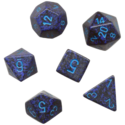
Back لعبة تقمص أدوار Arabic لعبة رول بلينج ARZ RPG BAT-SMG Gim rol-rolan BEW Ролева игра Bulgarian RPG BS Joc de rol Catalan کایەی ڕۆڵگێڕان CKB Hra na hrdiny Czech Сăнарлă вăйă CV
| Part of a series on |
| Role-playing games |
|---|
 |
| Types |
| Movements & Traditions |
| Parts of Games |
| Participants |
| Lists |
|
|
A role-playing game (sometimes spelled roleplaying game,[1][2] or abbreviated as RPG) is a game in which players assume the roles of characters in a fictional setting. Players take responsibility for acting out these roles within a narrative, either through literal acting or through a process of structured decision-making regarding character development.[3] Actions taken within many games succeed or fail according to a formal system of rules and guidelines.[4]
There are several forms of role-playing games. The original form, sometimes called the tabletop role-playing game (TRPG or TTRPG), is conducted through discussion, whereas in live action role-playing (LARP), players physically perform their characters' actions.[5] Both forms feature collaborative storytelling. In both TTRPGs and LARPs, often an arranger called a game master (GM) decides on the game system and setting to be used, while acting as a facilitator or referee. Each of the other players takes on the role of a single character in the fiction.[6]
Several varieties of RPG also exist in electronic media, such as multiplayer text-based Multi-User Dungeons (MUDs) and their graphics-based successors, massively multiplayer online role-playing games (MMORPGs). Role-playing games also include single-player role-playing video games in which players control a character, or team of characters, who undertake(s) quests. Role-playing video games may include player capabilities that advance over time using statistical mechanics. These electronic games sometimes share settings and rules with tabletop RPGs, but emphasize character advancement more than collaborative storytelling.[7][8]
Some RPG-related game forms, such as trading/collectible card games (CCGs) and wargames, may or may not be included under the definition of role-playing games. Although some amount of role-playing activity may be present in such games, it is not the primary focus.[9]
The term role-playing game is also sometimes used to describe other games involving roleplay simulation, such as exercises used in teaching, training, academic research, or therepeutic settings.
- ^ Harrigan, Pat; Wardrip-Fruin, Noah (2007). Second Person: Roleplaying and Story in Playable Media. MIT University Press. ISBN 9780262514187.
- ^ GURPS (4th ed.). Steve Jackson Games. 2004. pp. Chapter 1.
But roleplaying is not purely educational. It's also one of the most creative possible entertainments. Most entertainment is passive: the audience just sits and watches, without taking part in the creative process. In roleplaying, the "audience" joins in the creation, which may introduce a huge impact on the project. The GM is the chief storyteller, but the players are responsible for portraying their characters. If they want something to happen in the story, they make it happen, because they're in the story.
- ^ Grouling, Jennifer (2010). The Creation of Narrative in Tabletop Role-Playing Games. McFarland & Company. pp. 6. ISBN 978-0-7864-4451-9.
As suggested by the name, TRPGs are played face-to-face (around a table, most likely), and involve players 'acting out' a role. This acting is not always literal. Players do not arrive in costume or speak exclusively in character – something that differentiates TRPGs from live-action role-playing games (LARPs). Instead, players develop characters based on certain rules and are responsible for deciding what those characters do over the course of the game.
- ^ (Tychsen 2006:76) "The variety of role-playing games makes it inherently challenging to provide a common definition. However, all forms of role-playing games – be they PnP RPGs, CRPGs, MMORPGs, or LARPS – share a group of characteristics, which makes them identifiable from other types of games: storytelling with rules, control of fictional characters, a fictitious reality, usually the presence of a game master (or game engine), and at least one player."
- ^ (Tychsen et al. 2006:255) "LARPs can be viewed as forming a distinct category of RPG because of two unique features: (a) The players physically embody their characters, and (b) the game takes place in a physical frame. Embodiment means that the physical actions of the player are regarded as those of the character. Whereas in an RPG played by a group sitting around a table, players describe the actions of their characters (e.g., "I run to stand beside my friend")"
- ^ Kim, John. ""Narrative" or "Tabletop" RPGs". Archived from the original on 29 August 2008. Retrieved 9 September 2008.
- ^ (Tychsen 2006:75) "PnP RPGs are an example of interactive narratives. The rules and fictional worlds that form the basis for these games function as a vessel for collaborative, interactive storytelling. This is possibly the most important feature of PnP RPGs, and one that CRPGs have yet to reproduce."
- ^ Crawford, Chris (2003). Chris Crawford on Game Design. New Riders Publishing. pp. 163. ISBN 978-0-13-146099-7.
In some ways, the emphasis on character development has impeded progress in storytelling with RPGs. The central premise of these [computer RPGs] is that the player steadily builds his abilities by acquiring wealth, tools, weapons, and experience. This emphasis on character development tends to work against the needs of dramatic development – dramatic twists and turns clash with the prevailing tone of steady development. Fortunately, this impediment is not fundamental to the RPG genre; it is a cultural expectation rather than an architectural necessity.
- ^ (Heliö 2004) "In the family of role-playing games there are also a whole bunch of other game types and game-like activities that can be included or excluded, like the collectible card games (such as Magic: The Gathering) and board and strategy games (like Warhammer 40.000), or different forms of theatrical and larp-like combinations, such as fate-play. The action of role-playing is usually somehow present in these game forms, but the focus can be more either in the competitive nature of the game (MtG, Warhammer), or in the immersive performance (as in fate-play), than in role-playing itself."